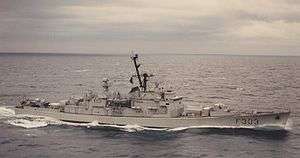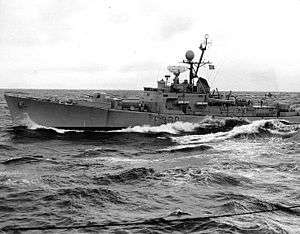Oslo-class frigate
The Oslo-class frigate is a Royal Norwegian Navy frigate design, based on the US Navy Dealey-class destroyer escorts. The forward hull was customized to suit Norwegian sea conditions better (higher freeboard) and several sub-systems were European built.[1]
 Stavanger | |
| Class overview | |
|---|---|
| Name: | Oslo class |
| Builders: | Navy Main Yard, Karljohansvern, Horten, Norway |
| Operators: |
|
| Succeeded by: | Fridtjof Nansen class |
| Built: | 1964–1966 |
| In commission: | 1966–2007 |
| Completed: | 5 |
| Lost: | 1 |
| Retired: | 3 |
| Preserved: | 1 |
| General characteristics | |
| Type: | Frigate |
| Displacement: |
|
| Length: | 96.6 m (316 ft 11 in) |
| Beam: | 11.2 m (36 ft 9 in) |
| Draft: | 5.5 m (18 ft 1 in) |
| Propulsion: | Twin steam boilers, one high pressure and one low pressure steam turbine, 20,000 hp (14,914 kW) |
| Speed: | 25 knots (29 mph; 46 km/h) |
| Range: | 3,900 nmi (7,200 km) at 15 kn (17 mph; 28 km/h) |
| Complement: | 120 (129 max) officers and men |
| Sensors and processing systems: |
|
| Electronic warfare & decoys: | 4 × Mark 36 SRBOC chaff launchers ESM: AR 700 suite |
| Armament: |
|
Construction
All ships were built at the Navy Main Yard in Horten, Norway between 1964 and 1966. The construction of the vessels was part of the Navy rebuilding program, approved by the Norwegian government in 1960. Half of the project expenses were funded by the United States as a part of the Mutual Defense Assistance Program (MDAP) (a program that ran from when it was passed by the Congress in October 1949 until 1967–68).
Modernization
In the late 1970s, the class received new armament, most notably Penguin, RIM-7 Sea Sparrow and Mark 32 torpedo launchers. Another modernization was carried out in the 1980s.
During 1995 and 1996, after HNoMS Oslo experienced an engine failure, and subsequently sank after sailing in heavy weather, the rest of the class was once again modernized. The hulls were strengthened, which in turn increased the displacement with 200 tonnes.[1]
All of the Oslo class are now retired, with HNoMS Narvik preserved as a museum ship. The Oslo class were replaced by the Fridtjof Nansen-class frigates. This replacement started in mid-2006.
Ships
Five frigates of this class were built. All of them were modernized during the period 1987–1990. They bear the prefix KNM (Kongelig Norske Marine, meaning Royal Norwegian Navy) in Norwegian and HNoMS (His Norwegian Majesty's Ship) in English.
| Name | Pennant number |
Launched | Commissioned | Decommissioned |
|---|---|---|---|---|
| Oslo | F300 | 17 January 1964 | 29 January 1966 | Sank in 1994 |
| Bergen | F301 | 23 August 1965 | 22 June 1967 | 3 August 2005 |
| Trondheim | F302 | 4 September 1964 | 2 June 1966 | June 2006 |
| Stavanger | F303 | 4 February 1966 | 8 December 1967 | June 1998 |
| Narvik | F304 | 8 January 1965 | 30 November 1966 | 1 August 2007[2] |
Oslo

The lead ship, Oslo, ran aground near Marstein island on 24 January 1994. One officer was killed in the accident. The next day, on 25 January, she was taken under tow. She sank on the same day in Korsfjorden outside Steinneset in Austevoll county.
Stavanger
Stavanger was decommissioned in 1998. She was later used for target practice and sunk in 2001 by a single DM2A3 torpedo launched from the Ula-class submarine Utstein (S 302).
Bergen
Bergen was decommissioned in August 2005.
Trondheim
On 17 March 2006 at 20:10 CET, Trondheim ran aground off Lines island in Sør-Trøndelag. No injuries among the 121-man crew were reported. The incident was reported from the ship itself, and at 20:30 it came loose again. Water flooded two compartments (paint storage and forward pump room) of the ship. The compartments were sealed and three ships were sent to assist the frigate.[3] The frigate was towed to port in Bergen by the coast guard vessel KV Tromsø.[4]
HNoMS Trondheim was used after decommissioning as a target ship. On 5 June 2013, she was severely damaged in a test of the Norwegian-designed Naval Strike Missile system off the coast of the island of Andøya.[5]
Narvik
Narvik, the last active ship of the class, has been transferred to the Royal Norwegian Navy Museum in Horten.[6]
References
- Chant, Chris (2004). Warships Today: Over 200 of the World's Deadliest Fighting Ships. Barnes & Noble. p. 112. ISBN 1-84509-007-1.
- Article on the decommissioning of HNoMS Narvik (in Norwegian) Archived 30 September 2007 at the Wayback Machine
- Johnsen, Christer S.; Simenstad, R.H. (17 March 2006). "KNM Trondheim tar inn vann" (in Norwegian). Adresseavisen. Retrieved 5 January 2015.
- Forsvarsnett, Godt redningsarbeid (in Norwegian) Archived 30 September 2007 at the Wayback Machine
- Robson, Steve (6 June 2013). "Caught on camera: The explosive moment Norwegian navy blew up its OWN ship to test new long-range missile". Daily Mail. Retrieved 5 January 2015.
- Forsvarsnett, Narvik to be museum ship (in Norwegian) Archived 30 September 2007 at the Wayback Machine
http://www.vgtv.no/#!/video/65152/her-sprenger-de-fregatten-med-ny-super-rakett
External links
- Kysteskadren Fregattvåpenet (in Norwegian)
- KNM Narvik (in Norwegian)
- Stavanger sunk by Utstein, YouTube video